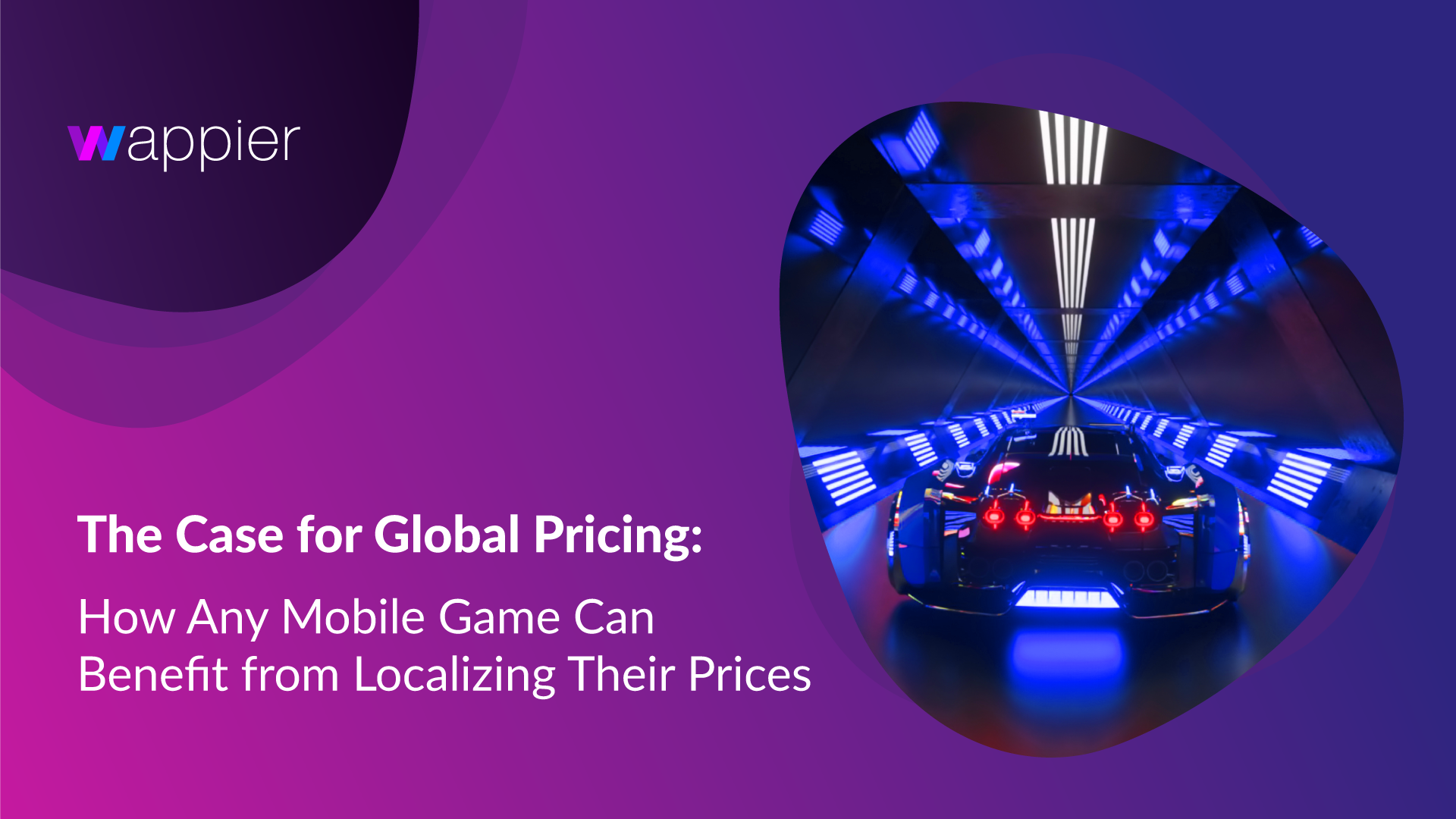It’s no secret that gaming is a lucrative industry. However, what many people don’t realize is that a big reason for this growth is the ever-increasing popularity of mobile games. In fact, mobile gaming is now estimated to make up almost half of the total gaming market, projected to surpass $136 billion in 2022, growing 1.7x faster than the gaming market overall.
And with such popularity came an explosion of different gaming genres, from the casual and hyper-casual games that are typically associated with mobile gaming, to more hardcore game genres like strategy and RPG.
However, one thing that all genres have in common is the need for global pricing strategies. Whether you’re a big AAA studio or a small indie developer, if you want to maximize your revenues, you need to be thinking about how to price your game in different regions.
But how do you go about localizing your game’s prices, and does the genre of your game play a role in why you should or shouldn’t use a certain pricing strategy?
What is localization and why is it important for mobile games?
When we think of game localization, we typically think of translating the game’s text and audio into different languages. That new role-playing game from Japan would be nearly impossible to play without a proper translation, and that somewhat curious Match-3 game from Korea would have benefited from some of its audio in English. Most people think of localization in this way because it’s the most visible form. However, true localization is much more than just that.
Localization is all about the process of adapting a game to specific locales, which includes not just language translation, but also things like culturalization, compliance with local laws and regulations, and something that most game publishers rarely think about: pricing for local demand.
When it comes to pricing your game in different regions, currency conversion is one of the most important things to consider. After all, if you want players in Japan to spend $10 on your game, that same $10 needs to be worth the same as it would be in the US. The exchange rate between two currencies can fluctuate quite a bit, and if you’re not careful, you could end up pricing your game too high or too low in certain regions.
In reality, though, what you want to do is not a price-to-price conversion: you want to do a value-to-value conversion. You want to make sure that the perceived value of your in-app prices is the same in all regions, regardless of the actual price.
For example, we all know that there’s a big difference between a $5 game that’s on sale and a $5 game that’s full price. But there is also a big difference between a $5 IAP price in the US and the equivalent price in Brazil. In the US, $5 is considered being a pretty good deal for an IAP, but in Brazil, that same price would be considered quite expensive.
The logic is sound: you just have to account for both the exchange rate and local purchasing power when pricing your game in different regions. But does it work for all mobile games regardless of genre?
The role of genre in pricing strategies
As we mentioned before, there are all sorts of different mobile games out there, and each genre has its own unique characteristics. For example, hyper-casual games tend to have simple gameplay and are often monetized through ads, whereas strategy and puzzle games tend to be more complex and can be monetized through in-app purchases.
Given these differences, it’s not surprising to believe that pricing strategies that work for one genre might not work for another. Hyper-casual games are typically monetized through ads, with in-app purchases that are mostly cosmetic or for convenience. On the other hand, the biggest match-3 and 4x strategy games drive most of their revenue through in-app-purchases. And it’s true that when it comes to what ads you use and how you use them, these genres differ quite a bit as well.
But when it comes to global pricing strategies, the lines start to blur a bit. In general, the same basic rules apply regardless of genre: you need to be aware of exchange rates and local purchasing power, and you need to make sure that your game is priced accordingly. From Match-3 to Hidden Objects, the genre plays little to no importance to whether you should localize your prices. In other words, localized practices help publishers make more money and help players have more fun, regardless of genre.
Of course, there are always exceptions to the rule. In some cases, it might make sense to carefully plan your pricing strategies to preserve your economy and retain a level playing field. For example, if your game is part of a competitive scene or relies on player-to-player interactions, you might not want to modify the prices of IAPs that give players an unfair advantage. That doesn’t mean pricing localization is a hard no for PVP games: it’s just more prudent to keep optimization only on cosmetic IAPs and avoid anything that would give a competitive edge.
But in most cases, from casual puzzle games like Genies & Gems to elaborate hidden object sensations like June’s Journey, global pricing strategies should be a key part of your localization efforts. By taking the time to properly price your game in each region, you can ensure that you are not leaving any money on the table – and that your game is as successful as it can be, no matter where it is being played.
So, if you are worried about how your game will perform in different regions, you need to localize your prices regardless of genre. It is the most optimal way to make sure that your game is priced appropriately, and to ensure that your players are getting the best value for their money.
And the best way to do that is with wappier’s Global Pricing.
What is Global Pricing and why is it important for mobile games?
Localized pricing leads to an increase in payer conversion, the number of transactions, and overall revenue. We’ve seen publishers make 20%–40% more money by changing prices on a per country level outside of the US and these changes are not based on private customer data. Instead, wappier uses publicly available datasets that include a country’s GDP, currency exchange rates, and other economic indicators along with device penetration, game statistics, and more to create a proprietary index of price elasticities for mobile game purchases across countries.
Since 2018, wappier’s Global Pricing product has been used to find the best IAP prices for several top tier mobile games across genres. During this process, we predicted new demand curves for countries outside of the US, which let us set prices that are more accurate for each country. So, after three months, the games’ average revenue per user (ARPU) went up by a global average of 55%, with developing countries seeing the most growth.
Just a few examples of successful Global Pricing strategies across genres:
– Hollywood Story is a casual adventure game by Nanobit where players take on the life of an aspiring Hollywood starlet. Nanobit launched Global Pricing for Hollywood Story in October 2019 and saw immediate results: 20% increase in ARPU and a whopping 60% in average transactions.
– June’s Journey is one of the most popular hidden object games in the App Store, with over 25 million downloads. When Wooga, the game’s developer, launched Global Pricing they saw a 20% increase in paying users that had a direct positive effect on revenue.
– And Genies & Gems, a top Match-3 game by Jam City, experienced improved ARPU by 18% and also saw paying players increase by 13% (who then boosted transactions by 13%). Using Global Pricing to target specific countries with optimized prices further increased their revenue and resulted in global KPI lifts.
From these increases in ARPU and other KPIs we can deduce that, first, lower prices in developing economies bring in a lot of new buyers. Second, publishers can still make more money in highly developed economies like Germany by making IAPs fit with what people are willing to pay there. And third, it means that regardless of the genre of your mobile game, using wappier’s Global Pricing will help you to set prices that are appropriate for each region. This will ensure that your players are getting the best value for their money, and it will help you to make more money from your game.
Global Pricing is genre-agnostic
There are many factors to consider when pricing IAPs for mobile games. But one thing that’s important to remember is that localized pricing is not genre specific. That means that whether your game is a casual game, a midcore game, or a hardcore game, you can use wappier’s Global Pricing to find the best prices for your IAPs in each region.






